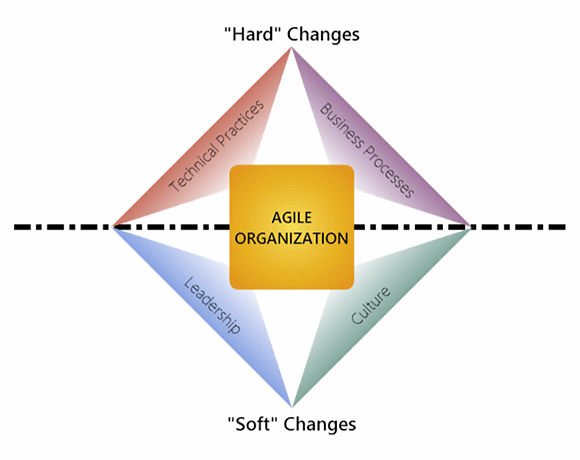Four elements of creating business agility
Organizational agility expert Joseph Flahiff lays out four practices that lead to business agility.
I am often asked the question, "What do we need to do to make our business agile?"
The problem is no one can answer that question until your organizational functions and dysfunctions are better known. When I am done working with a business and it is nimble, the business has similarities to other nimble organizations such as Southwest Airlines, Pixar and PayPal. Business agility looks different in these organizations but a few common elements allow them to be nimble. Just to be clear, I am not just talking about doing Scrum. I am talking about being a nimble organization that can make changes as fast as or faster than the changes are coming at them. These may be changes in customer needs, market dynamics or industry trends. For example, nimble businesses adapt quickly and can easily adopt new technologies like cloud and mobile.

When I start working with organizations, they are all over the map. Some parts of the organization are readily able to be nimble while others are very staid and inflexible. There is no direct answer for the question. Each organization's path is different. It is like asking, "How do I get to Omaha, Nebraska?" People want you to tell them, go north, then east, then north again. But if you are already north of Omaha, that will only take you further away. There is no one right answer for how to start.
My response is,"What makes you believe your business is not agile?"
The answer to that reveals where the business' ability and approach to adapting to change falls short. Looking at this through the lens of the four aspects of agility (4AA) -- technical practices, business processes, culture and leadership -- will help locate where the organization is coming from. And from that, you'll know how to move toward looking and acting nimble.
Business agility in four steps
What does business agility look like? Let's examine that question with the 4AA model, working clockwise starting with technical practices.

TECHNICAL PRACTICES -- When an organization operates in a nimble way, technical practices are the practical tools and techniques used by teams, management and leadership to deliver customer value quickly and incrementally.
Flexible technical practices do not merely make exceptions for the possibility of change, but they also are based upon the certainty of change and are designed to leverage it for the benefit of the customer and the business. The one defining mark of an agile business is that it is able to respond to changes as fast as or faster than the changes happen. This means that it delivers value to its customers quickly and has defined feedback loops.
BUSINESS SYSTEMS -- In nimble organizations, business systems are the set of continuously evolving and improving processes, tools, beliefs and policies that support the business. Agile/nimble business systems enable managers and leadership to make quick decisions, and they support the prioritization of work that enables the delivery of customer and business value.
Agile/nimble business systems support the technical practices and are enabled by the leadership. They are the systems that enable teams, business leaders, analysts and managers to easily work together in tight-knit groups to deliver customer value.
The one defining mark of an agile business is that it is able to respond to changes as fast as or faster than the changes happen.
CULTURE -- Culture is a set of organizational beliefs and behaviors. An agile/nimble organization supports the ability to adapt to changes as they come. A high value is placed on being transparent and realistic, even about the "bad news." These cultures focus on the delivery of one thing: customer value above all. These organizations have fully engaged teams that self-organize with motivated team members who collaborate in real time. These organizations are characterized by a high psychological security and the sense that it is safe to speak your mind, even if it contradicts someone in authority. It's not only tolerated, but encouraged. A mindset of continuous improvement is the key to long-term success.
LEADERSHIP -- The leaders' job is twofold: First, leaders provide vision and parameters that will guide the organization. These types of leaders do not spend their time defining what exactly needs to be done or how it should be done; they trust that the teams are capable. Second, leaders are the removers of obstacles and smoothers of paths allowing the teams to self-organize and find their own path to delivering the project.
When I draw the above diagram at client sites, I often draw it more like an iceberg than a diamond, to emphasize the importance of the soft aspects (culture and leadership). These two are the most important aspects for the long-term success of your journey toward more business agility. It is easy to focus on the hard aspects because they are easy to see and easy to implement. Culture and leadership are hard to change, but it is an effort worth pursuing because it can make all the difference.
More Agile business advice from Joseph Flahiff
Don't limit lessons learned to project post mortems
Get started with Agile project management
Agile approaches for on-time and on-budget projects
One government agency I have worked with for three years has shown great success in adopting the hard changes across the agency, but only some of the agency has changed its culture. The areas of the agency that have changed its culture continue to grow in their ability to deliver value quickly. Those that did not successfully change their culture have slowly slid back to their old ways of doing things. They adopted great technical practices and business processes but their culture and leadership did not change.
Now, consider your organization. Do the above four aspects describe it?
The only way to draw a line is with two points. One point is the North Star of the four aspects of agility. The second point is where you are today. Don't let anyone tell you what you need to do before he or she knows who you are.
About the author:
Joseph Flahiff, founder of Whitewater Projects Management Consulting, advises businesses on becoming nimble in the 21st century market. Before establishing Whitewater Projects, Flahiff worked for a multi-state health insurance company, providing Agile project management and training for a three-year $20 million project that coordinated the work of more than 100 team members.








